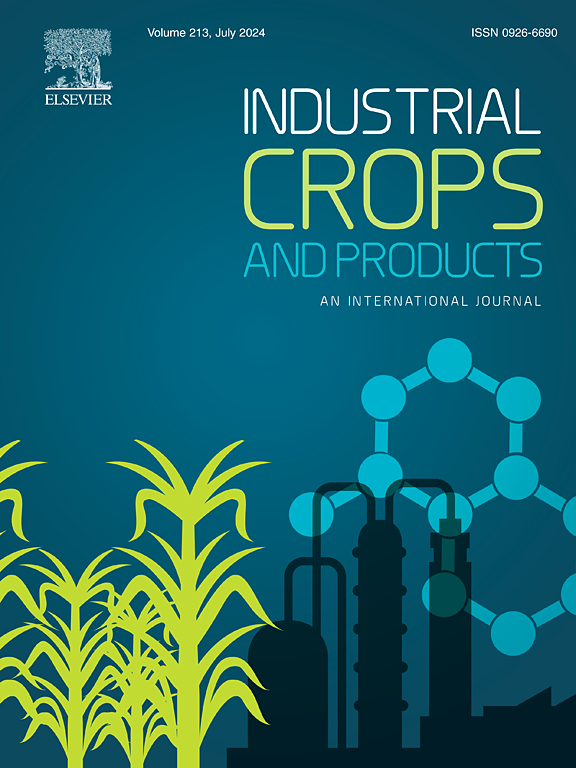Enhancement of bioactive compound extraction from Rhus chinensis leaves using the polyol-based ultrasound-assisted method: Antioxidant, anti-melanogenesis, and pollution defense properties
IF 6.2
1区 农林科学
Q1 AGRICULTURAL ENGINEERING
引用次数: 0
Abstract
This study investigates the optimization of polyol-based ultrasound-assisted extraction (UAE) for Rhus chinensis (RC) leaves to enhance the extraction of bioactive compounds with antioxidant, anti-melanogenesis, and pollution defense properties. Through a mixture design, the highest total phenolic content (TPC) was achieved using a solvent composed of 33.29 % butylene glycol, 33.39 % glycerin, and 33.31 % water. The effects of extraction time and solvent-to-material ratio on TPC, total tannin content (TTC), and antioxidant activities (DPPH, ABTS, FRAP) were evaluated using a central composite design (CCD). Optimal conditions were found to be 15 min of extraction time and a solvent-to-material ratio of 32.29:1, resulting in the highest recovery of bioactive compounds. The polyol-based UAE method outperformed traditional extraction techniques, yielding superior antioxidant activities and demonstrating strong potential for cosmeceutical applications. Analysis of the RC extract revealed several bioactive compounds, including myrsinone, verbasoside, 6-pentadecyl salicylic acid, and salicyl alcohol. The RC extract exhibited significant free radical scavenging, melanogenesis inhibition, and pollution defense properties, positioning it as a promising ingredient in skincare formulations aimed at combating oxidative stress while promoting skin lightening, and offering environmental protection. These results provide a scientific foundation for the development of natural, high-performance skincare products, showcasing the efficacy of polyol-based UAE as an advanced technique for extracting functional compounds from botanicals.
基于多元醇的超声辅助提取法增强五倍子叶生物活性化合物的抗氧化、抗黑素生成和抗污染性能
本文研究了超声辅助提取法(UAE)对Rhus chinensis (RC)叶中抗氧化、抗黑素生成和抗污染活性物质的提取效果。通过混合物设计,采用33.29 %丁二醇、33.39 %甘油和33.31 %水组成的溶剂,总酚含量(TPC)最高。采用中心复合设计(CCD)评价提取时间和料液比对TPC、总单宁含量(TTC)和抗氧化活性(DPPH、ABTS、FRAP)的影响。最佳提取条件为萃取时间为15 min,料液比为32.29:1,生物活性化合物的回收率最高。多元醇为基础的阿联酋方法优于传统的提取技术,产生优越的抗氧化活性,并显示出药妆应用的强大潜力。对紫薇提取物的分析发现了几种生物活性化合物,包括桃金子酮、毛蕊花苷、6-十六烷基水杨酸和水杨醇。该提取物具有显著的自由基清除、黑素生成抑制和污染防御特性,使其成为对抗氧化应激、促进皮肤亮白和提供环境保护的护肤配方中有前景的成分。这些结果为开发天然、高性能的护肤产品提供了科学基础,展示了多元醇为基础的UAE作为一种从植物中提取功能化合物的先进技术的功效。
本文章由计算机程序翻译,如有差异,请以英文原文为准。
求助全文
约1分钟内获得全文
求助全文
来源期刊

Industrial Crops and Products
农林科学-农业工程
CiteScore
9.50
自引率
8.50%
发文量
1518
审稿时长
43 days
期刊介绍:
Industrial Crops and Products is an International Journal publishing academic and industrial research on industrial (defined as non-food/non-feed) crops and products. Papers concern both crop-oriented and bio-based materials from crops-oriented research, and should be of interest to an international audience, hypothesis driven, and where comparisons are made statistics performed.
 求助内容:
求助内容: 应助结果提醒方式:
应助结果提醒方式:


